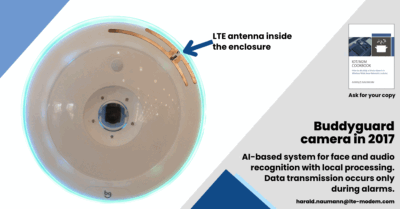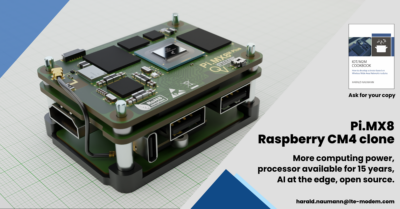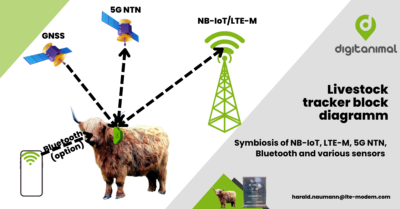In 2015, the startup BuddyGuard launched a campaign on Kickstarter. The product was the Flare security camera. Faces and suspicious noises were to be recognised locally on the camera. The homeowner was proactively warned of intruders.

5G camera
A revolutionary approach:
AI-based face and audio recognition: The camera differed from the competition in that it processed video material locally on the device itself. Transmission only occurred when a threat was detected.
Advanced sound recognition: The camera was able to distinguish between normal and suspicious sounds and send targeted messages.
Despite high funding, BuddyGuard failed:
Lack of capital: Although a whopping €3.4 million was raised in 2017, it was not enough. The vision was not realised.
Lack of trust: We assume that a lack of experience in wireless IoT and a lack of scaling led to the withdrawal of investors.
Production stopped: Only a few hundred cameras were produced. Numerous circuit boards ended up in the e-waste dump.
Learning from mistakes: A new chapter and a proposal for a redesign of the camera.
With today’s knowledge, the camera idea can be revived and the mistakes of the past avoided.
Base: Raspberry Pi CM4 Clone

Raspberry Pi CM4 Clone
No new hardware development: Lukas Henkel‘s open-source Raspberry Pi CM4 clone forms the basis of the new camera.
Open-source software: Libraries for face recognition and audio are freely available and reduce development costs.
Housing and camera: The housing and camera can be developed by the author’s team, which recently won the 5G NTN Award for the best antenna design at Deutsche Telekom.
5G-NTN tracker with AI for Digitanimal

5G NTN tracker
The author’s team has experience in developing IoT devices. This includes antennas and housings. They are currently developing a 5G NTN tracker with little AI for Digitanimal in Spain. By the way, requests for distribution and OEM versions are welcome.
New 5G camera: An innovative security concept
The new camera combines the advantages of the original idea with current technology:
AI-based local analysis: faces and sounds are still recognised on the device itself.
5G connectivity: fast and reliable data transfer in the event of a recognised threat.
Extended functions: integration of further AI-based functions such as object and motion detection possible.
Conclusion:
The BuddyGuard story shows that even brilliant ideas can fail if not implemented professionally. However, with the right expertise and the right partners, the redesign can be a success.
Let’s reinvent the camera and shape the smart security of the future! Here is the recipe.
Ingredients for a cheaper and more powerful redesign of the camera:
– 1 Raspberry Pi CM4 clone (open source)
– 1 improved 5G module (approx. 60% cheaper than standard)
– 1 combined WiFi/Bluetooth module
– 1 5G LTE chip antenna (40 cents, 60% cheaper than standard)
– 1 integrated WiFi/Bluetooth antenna (0 cents)
– 1 5G Global IoT SIM card (approx. 50% cheaper than standard)
– 1 backup battery
– 1 multi-mode camera module
Preparation:
1. Connect the improved 5G module to the low-cost 5G LTE chip antenna. Gently stir until a stable connection is formed.
2. Add the WiFi/Bluetooth module and integrate the free WiFi/Bluetooth antenna. Let them merge well together.
3. Add the Global IoT SIM card and season with worldwide connectivity.
4. Fold the backup battery in carefully to ensure an uninterrupted power supply.
5. Place the multi-mode camera module in the centre and garnish it with artificial intelligence for facial recognition.
6. Use the Raspberry Pi CM4 clone as a base and let everything simmer on the open-source platform.
7. Finally, sprinkle a pinch of data protection and a dash of cybersecurity over the whole thing.
8. Let it all steep until you have a smart, cost-effective and powerful security camera.
Serving suggestion: Set up the new 5G camera in your home, connect it to the camera app and enjoy increased security with intelligent intrusion protection and automatic police notification.
Would you like to receive the full recipe for our revolutionary, cost-effective security solution? Contact me today at harald.naumann(at) lte-modem. com for detailed information and a personal consultation. Together, we can shape the future of smart home monitoring!